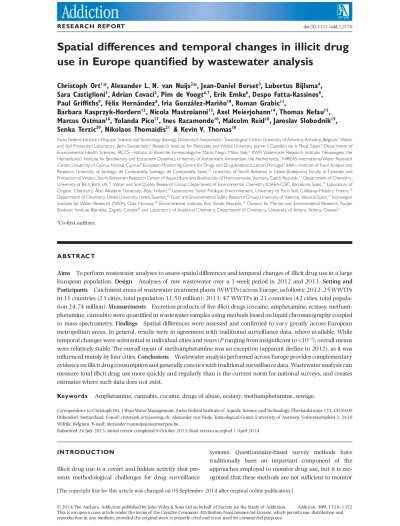Summary
Wastewater analysis can measure total illicit drug use more quickly and regularly than is the current norm for national surveys, and creates estimates where such data does not exist.
Download as PDF
Open access PDF
PDF files are made available as a convenience. In cases where the EMCDDA is not the originator of the document, please be aware that any PDFs available on this page may not be authoritative or there may be more recent versions available. While we make every effort to ensure that these files are definitive, before using or citing them, we recommend that you consult the publisher's website or contact the author(s) to check for more recent versions.
Abstract
Aims
To perform wastewater analyses to assess spatial differences and temporal changes of illicit drug use in a large European population.
Design
Analyses of raw wastewater over a 1-week period in 2012 and 2013.
Setting and Participants
Catchment areas of wastewater treatment plants (WWTPs) across Europe, as follows: 2012: 25 WWTPs in 11 countries (23 cities, total population 11.50 million); 2013: 47 WWTPs in 21 countries (42 cities, total population 24.74 million).
Measurements
Excretion products of five illicit drugs (cocaine, amphetamine, ecstasy, methamphetamine, cannabis) were quantified in wastewater samples using methods based on liquid chromatography coupled to mass spectrometry.
Findings
Spatial differences were assessed and confirmed to vary greatly across European metropolitan areas. In general, results were in agreement with traditional surveillance data, where available. While temporal changes were substantial in individual cities and years (P ranging from insignificant to <10−3), overall means were relatively stable. The overall mean of methamphetamine was an exception (apparent decline in 2012), as it was influenced mainly by four cities.
Conclusions
Wastewater analysis performed across Europe provides complementary evidence on illicit drug consumption and generally concurs with traditional surveillance data. Wastewater analysis can measure total illicit drug use more quickly and regularly than is the current norm for national surveys, and creates estimates where such data does not exist.









